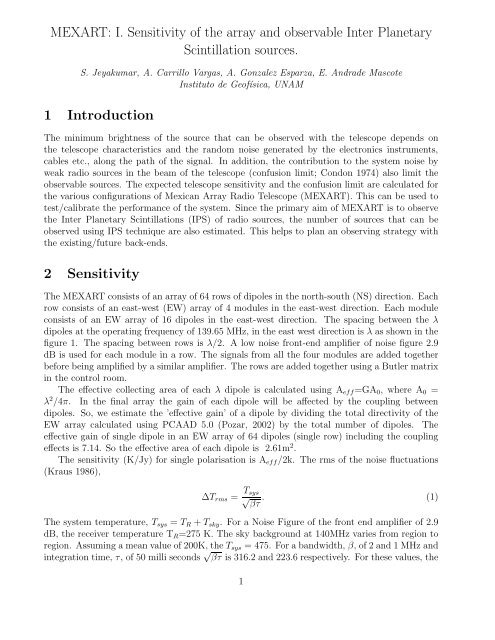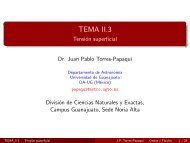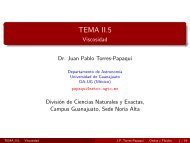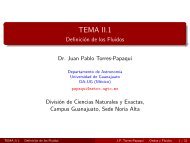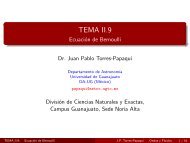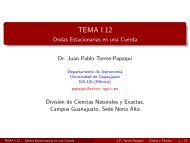MEXART: I. Sensitivity of the array and observable Inter Planetary ...
MEXART: I. Sensitivity of the array and observable Inter Planetary ...
MEXART: I. Sensitivity of the array and observable Inter Planetary ...
You also want an ePaper? Increase the reach of your titles
YUMPU automatically turns print PDFs into web optimized ePapers that Google loves.
<strong>MEXART</strong>: I. <strong>Sensitivity</strong> <strong>of</strong> <strong>the</strong> <strong>array</strong> <strong>and</strong> <strong>observable</strong> <strong>Inter</strong> <strong>Planetary</strong><br />
Scintillation sources.<br />
S. Jeyakumar, A. Carrillo Vargas, A. Gonzalez Esparza, E. Andrade Mascote<br />
Instituto de Ge<strong>of</strong>ísica, UNAM<br />
1 Introduction<br />
The minimum brightness <strong>of</strong> <strong>the</strong> source that can be observed with <strong>the</strong> telescope depends on<br />
<strong>the</strong> telescope characteristics <strong>and</strong> <strong>the</strong> r<strong>and</strong>om noise generated by <strong>the</strong> electronics instruments,<br />
cables etc., along <strong>the</strong> path <strong>of</strong> <strong>the</strong> signal. In addition, <strong>the</strong> contribution to <strong>the</strong> system noise by<br />
weak radio sources in <strong>the</strong> beam <strong>of</strong> <strong>the</strong> telescope (confusion limit; Condon 1974) also limit <strong>the</strong><br />
<strong>observable</strong> sources. The expected telescope sensitivity <strong>and</strong> <strong>the</strong> confusion limit are calculated for<br />
<strong>the</strong> various configurations <strong>of</strong> Mexican Array Radio Telescope (<strong>MEXART</strong>). This can be used to<br />
test/calibrate <strong>the</strong> performance <strong>of</strong> <strong>the</strong> system. Since <strong>the</strong> primary aim <strong>of</strong> <strong>MEXART</strong> is to observe<br />
<strong>the</strong> <strong>Inter</strong> <strong>Planetary</strong> Scintillations (IPS) <strong>of</strong> radio sources, <strong>the</strong> number <strong>of</strong> sources that can be<br />
observed using IPS technique are also estimated. This helps to plan an observing strategy with<br />
<strong>the</strong> existing/future back-ends.<br />
2 <strong>Sensitivity</strong><br />
The <strong>MEXART</strong> consists <strong>of</strong> an <strong>array</strong> <strong>of</strong> 64 rows <strong>of</strong> dipoles in <strong>the</strong> north-south (NS) direction. Each<br />
row consists <strong>of</strong> an east-west (EW) <strong>array</strong> <strong>of</strong> 4 modules in <strong>the</strong> east-west direction. Each module<br />
consists <strong>of</strong> an EW <strong>array</strong> <strong>of</strong> 16 dipoles in <strong>the</strong> east-west direction. The spacing between <strong>the</strong> λ<br />
dipoles at <strong>the</strong> operating frequency <strong>of</strong> 139.65 MHz, in <strong>the</strong> east west direction is λ as shown in <strong>the</strong><br />
figure 1. The spacing between rows is λ/2. A low noise front-end amplifier <strong>of</strong> noise figure 2.9<br />
dB is used for each module in a row. The signals from all <strong>the</strong> four modules are added toge<strong>the</strong>r<br />
before being amplified by a similar amplifier. The rows are added toge<strong>the</strong>r using a Butler matrix<br />
in <strong>the</strong> control room.<br />
The effective collecting area <strong>of</strong> each λ dipole is calculated using Aeff=GA0, where A0 =<br />
λ 2 /4π. In <strong>the</strong> final <strong>array</strong> <strong>the</strong> gain <strong>of</strong> each dipole will be affected by <strong>the</strong> coupling between<br />
dipoles. So, we estimate <strong>the</strong> ’effective gain’ <strong>of</strong> a dipole by dividing <strong>the</strong> total directivity <strong>of</strong> <strong>the</strong><br />
EW <strong>array</strong> calculated using PCAAD 5.0 (Pozar, 2002) by <strong>the</strong> total number <strong>of</strong> dipoles. The<br />
effective gain <strong>of</strong> single dipole in an EW <strong>array</strong> <strong>of</strong> 64 dipoles (single row) including <strong>the</strong> coupling<br />
effects is 7.14. So <strong>the</strong> effective area <strong>of</strong> each dipole is 2.61m 2 .<br />
The sensitivity (K/Jy) for single polarisation is Aeff/2k. The rms <strong>of</strong> <strong>the</strong> noise fluctuations<br />
(Kraus 1986),<br />
∆Trms = Tsys<br />
√ . (1)<br />
βτ<br />
The system temperature, Tsys = TR + Tsky. For a Noise Figure <strong>of</strong> <strong>the</strong> front end amplifier <strong>of</strong> 2.9<br />
dB, <strong>the</strong> receiver temperature TR=275 K. The sky background at 140MHz varies from region to<br />
region. Assuming a mean value <strong>of</strong> 200K, <strong>the</strong> Tsys = 475. For a b<strong>and</strong>width, β, <strong>of</strong> 2 <strong>and</strong> 1 MHz <strong>and</strong><br />
integration time, τ, <strong>of</strong> 50 milli seconds √ βτ is 316.2 <strong>and</strong> 223.6 respectively. For <strong>the</strong>se values, <strong>the</strong><br />
1
Figure 1: The block diagram <strong>of</strong> <strong>MEXART</strong> EW <strong>array</strong> <strong>of</strong> dipoles<br />
rms noise, ∆Trms <strong>and</strong> minimum detectable flux density ∆Srms = (2k/Aeff)∆Trms are estimated<br />
(see Table 1)<br />
The coupling between NS elements will influence <strong>the</strong> aperture efficiency. This factor is not<br />
known, so we use a value <strong>of</strong> 0.7 measured using Crab nebula as <strong>the</strong> aperture efficiency. This<br />
value is used for <strong>the</strong> calculation <strong>of</strong> <strong>the</strong> effective area using <strong>the</strong> physical area, for <strong>the</strong> NS <strong>array</strong> <strong>of</strong><br />
rows.<br />
3 Confusion limit<br />
The confusion noise due to faint radio sources within <strong>the</strong> beam depends on <strong>the</strong> beam size <strong>and</strong><br />
<strong>the</strong> frequency. The confusion limit is defined as (Condon 1974),<br />
Sc =<br />
q 3−γ<br />
3 − γ<br />
1<br />
1−γ<br />
(n0Ωb) 1<br />
1−γ , (2)<br />
where γ <strong>and</strong> n0 are defined as, n(s)ds = n0s γ ds. Here n(s) is <strong>the</strong> differential source count. The<br />
effective telescope beam,<br />
Ωb = π θ1θ2<br />
4 (γ − 1)ln(2)<br />
2
Table 1: Expected telescope sensitivity <strong>and</strong> confusion limit for various configurations<br />
Configuration Area <strong>Sensitivity</strong> ∆Srms ∆Srms Confusion limit<br />
m 2 K/Jy Jy Jy Jy<br />
(β=2MHz) (β=1MHz)<br />
1 module 41.7 0.0151 99 140 397<br />
1 row 167.86 0.0608 25 35 137<br />
2 rows 205⋆ 0.074 20 29 133<br />
4 rows 411⋆ 0.149 10 14 57<br />
16 rows 1644⋆ 0.595 2.5 3.6 16.5<br />
Full <strong>array</strong> 6576⋆ 2.38 0.6 0.9 5.43<br />
⋆ Calculated by assuming an efficiency factor <strong>of</strong> 0.7.<br />
The beam widths in two perpendicular directions are denoted by θ1 <strong>and</strong> θ2. The factor q is<br />
usually taken to be 5. The source count at 178 MHz from <strong>the</strong> Cambridge survey provides<br />
γ = 2.3 <strong>and</strong> n0 = 1.0 × 10 3 sources/sr. Since <strong>the</strong> operating frequency <strong>of</strong> <strong>MEXART</strong> is closer to<br />
this frequency, <strong>the</strong> source count at 178MHz are used for <strong>the</strong> calculations. Using <strong>the</strong>se values,<br />
Sc = 4.1454(θ ′′<br />
1 θ′′<br />
2 )1/1.3 Jy. (3)<br />
The confusion limit for different configurations are also listed in table 1.<br />
4 Observable sources<br />
For detection at 3σ level with 2MHz b<strong>and</strong>width, <strong>the</strong> detection limit is about 1.8 Jy. For a<br />
spectral index <strong>of</strong> 0.75, this detection limit at 178 MHz is smaller by factor <strong>of</strong> 1.137. This yields<br />
a detection limit <strong>of</strong> 1.6 Jy at 178MHz. The number <strong>of</strong> sources brighter than 1.6 Jy at 178MHz is<br />
4900 (obtained using NED). Limiting <strong>the</strong> observations to elongation angles less than 45 degrees<br />
limits <strong>the</strong> declination to ±68.5 degrees, <strong>and</strong> <strong>the</strong> number <strong>of</strong> sources <strong>observable</strong> within this range<br />
are about 4600. Restricting <strong>the</strong> scintillation targets to elongation angles between 45 <strong>and</strong> 15<br />
degrees, <strong>the</strong> fraction <strong>of</strong> sky covered is about 0.108. Thus <strong>the</strong> number <strong>of</strong> sources that can be<br />
easily detected using IPS technique in a day are about 460 (see also next section).<br />
5 IPS <strong>of</strong> radio sources<br />
At <strong>the</strong> telescope operating frequency <strong>of</strong> 139.65 MHz, <strong>the</strong> angular size <strong>of</strong> <strong>the</strong> source that will<br />
scintillate is about 1 arcsec. In case <strong>of</strong> extended sources, <strong>the</strong> compact components that are<br />
smaller than 1 arcsec will scintillate. The scintillation index, m = ∆Srms/ST, where ∆Srms is<br />
<strong>the</strong> scintillating flux <strong>and</strong> ST is <strong>the</strong> total flux <strong>of</strong> <strong>the</strong> source. For sources detected at N σ level <strong>the</strong><br />
lower limit to <strong>the</strong> scintillation index, m, is 1/N. For example, for a 5σ detection, scintillation<br />
index greater than 0.2 is measurable.<br />
The scintillation index <strong>of</strong> a point source decreases as <strong>the</strong> elongation angle (ǫ), <strong>the</strong> angle<br />
subtended by <strong>the</strong> lines <strong>of</strong> sights to <strong>the</strong> source <strong>and</strong> <strong>the</strong> Sun from <strong>the</strong> observer, increases. The<br />
3
Scintillation index<br />
1<br />
0.1<br />
0.01<br />
0.001<br />
15.0 18.1 21.88<br />
26.56<br />
32.46<br />
40.08<br />
Elongation<br />
50.6<br />
Figure 2: Variation <strong>of</strong> scintillation index with solar elongation angle.<br />
68.02<br />
scintillation index, m, is related to ǫ as m ∝ sin(ǫ) −1.75 (Manoharan et al., 1995) as shown<br />
in figure 2. A lower limit on <strong>the</strong> scintillation index sets an upper limit on <strong>the</strong> elongation angle<br />
up to which scintillations can be measured. The lower-limit to <strong>the</strong> m <strong>and</strong> <strong>the</strong> corresponding<br />
upper-limit to <strong>the</strong> ǫ are given in <strong>the</strong> table 2, for different detection limits.<br />
6 Scintillation map <strong>and</strong> observing strategy<br />
The region set by <strong>the</strong> ǫ limit above are shown in figure 3. For an integration time <strong>of</strong> 50 ms, <strong>the</strong><br />
minimum detectable flux is 0.6 Jy. Assuming that most <strong>of</strong> <strong>the</strong> sources are close to <strong>the</strong> detection<br />
limit, <strong>the</strong> number <strong>of</strong> sources that would fall within each zone are given in <strong>the</strong> table 2. This is<br />
calculated assuming that <strong>the</strong> lines <strong>of</strong> sights with elongation angles less than 15 ◦ are not observed<br />
due to strong scattering. Since <strong>the</strong> telescope is a transit instrument, <strong>the</strong> above elongation angles<br />
correspond to a transit time (see <strong>the</strong> table 2). During <strong>the</strong> transit time <strong>the</strong> observations can be<br />
carried out. For a source <strong>the</strong> ON source time is about 5 mins. Assuming 10 mins <strong>of</strong> observing<br />
time for each source including <strong>the</strong> OFF source observations, <strong>the</strong> total data-time is about 31<br />
hours for 5σ <strong>and</strong> 34 hours for 10σ detection. To acquire <strong>the</strong> data within <strong>the</strong> transit time <strong>of</strong> <strong>the</strong><br />
IPS-zone <strong>the</strong> required receivers are 6 for 5 σ detection <strong>and</strong> 3 for 10 σ detection. The number<br />
<strong>of</strong> sources that can be observed with elongation angles less than about 75 degree are about 650.<br />
These sources can be observed using 7 receivers over a transit time <strong>of</strong> 10 hours.<br />
4
90<br />
>10 σ<br />
8 σ 5σ<br />
60<br />
30<br />
Figure 3: Region <strong>of</strong> <strong>the</strong> sky with <strong>the</strong> detection/scintillation index limit.<br />
3σ<br />
Table 2: Table <strong>of</strong> IPS-zone <strong>and</strong> <strong>the</strong> number <strong>of</strong> sources.<br />
Observing limit m-limit ǫ-limit Number <strong>of</strong> sources Transit Time<br />
degree Total IPS-zone (Hour)<br />
1.8 Jy (3σ) 0.33 29 4900 230 3.87<br />
3.0 Jy (5σ) 0.2 40 3000 310 5.3<br />
6.0 Jy (10σ) 0.1 75 826 340 10.0<br />
7 Conclusion<br />
The sensitivity <strong>and</strong> <strong>the</strong> confusion limit <strong>of</strong> <strong>the</strong> radio <strong>array</strong>, <strong>MEXART</strong> are estimated. These values<br />
are tabulated for various configurations <strong>of</strong> <strong>the</strong> <strong>array</strong>, so that comparison can be made with<br />
observations aimed at calibrating <strong>the</strong> <strong>array</strong>. Based on <strong>the</strong> sensitivity estimates, an observing<br />
strategy is formulated for <strong>the</strong> observations <strong>of</strong> scintillating sources.<br />
8 References<br />
1. Condon, J. J. 1974, ApJ, 188, 279<br />
2. Kraus, J. D., 1986, “Radio Astronomy”, 2nd ed., Cygnus Quasar Book, Powell.<br />
3. Manoharan, P. K., Ananthakrishnan, S., Dryer, M., Detman, T. R., Leinbach, H., Kojima,<br />
5
M., Watanabe, T., & Kahn, J. 1995, Sol. Phys., 156, 377<br />
4. Pozar M. D., 2002, PCAAD 5.0: Personal Computer Aided Antenna Design, Inc. Leverett,<br />
MA.<br />
6


